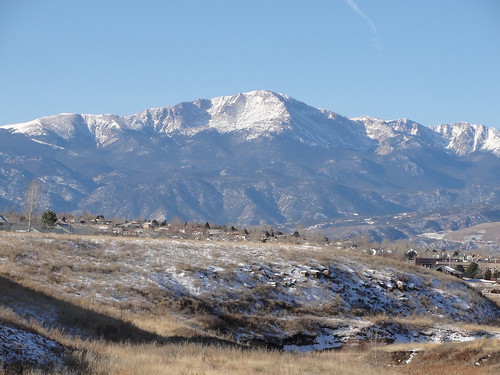
(Pike's Peak, about a week ago.)
It’s coming.
Like a legion of demons riding on grey fiberglass wool. Like the dark cloud Sauron created to shield his orcs. It is flying over the foothills, from north to south, enveloping the western mountains in darkness.
In the southeast, the sun shines brightly through a strip of higher, more benign clouds. They’re white, toothed like a serrated palm. They appeared out of nowhere as moisture in the air—last week's snowfall—condensed with the frigid in-coming air. The sun glows on the light haze, making streets and cars appear a little fuzzy, like someone messed with the brightness dial on a photo-editor.
The menace of grey, though, is almost to the Peak. I fled it earlier. Its vanguard wind had already taken the Academy in its icy grip. I fled south. Flags, whipping to the south truer than any magnetic compass, reached desperately for the milder climes of New Mexico, begged me to take them with me. But I knew I wasn’t going far enough.
The dark grey is breaking up. Not disappearing—spreading. It is just realizing it isn’t alone. After a steady, relentless trek from Canada, straight down the Rockies, it now meets its enemy from the east. Cold will battle dry as the two fronts crash. And all of Colorado Springs will watch from the frontlines.
My mom used to say that if you don’t like the weather in Portland, wait five minutes. She never lived in Colorado. Portland’s weekly forecast can read high of 45, low of 40. Colorado will go from 60 to 0 without a backward glance. Just this morning, I watched the sunlight illuminate Pike’s Peak, defining crevasses and contours usually lost to the flat light of day. Now—just now—the fourteener has disappeared behind the clouds from the north. Weather is a dynamic thing here—a living, breathing entity that must be dealt with. And, even in its most benign summer days, Pike’s Peak is an ever-attentive old man, watching over its city. The Springs is the only place I know where you can watch and hear a front come in. Literally.
I read somewhere that all sci fi writers could do worse than to read Louis L’Amour. He knew his setting—the hills and deserts of the American southwest. He wrote the land as a character to be reckoned with.
Sometimes, sci fi writers take this literally. Both the moon Pandora on Avatar, and Elizabeth Scarborough’s PeTayBee are alive and active with their inhabitants. In the movie The Fellowship of the Rings, it is Saruman who conjures the storm on Mt. Caradhras. But in the book, it is the mountain, himself, who resents unwanted intruders and does his best to drive them away.
Some sci fi settings are living, but some are just treated as if they’re alive. I can’t be the only person whose heart beat with joy at the opening scene of Serenity with its tour of the ship. Even Nathan Fillion, upon arriving at the set after the long hiatus between TV show and movie, said he felt like he was coming home. And, when playing Star Wars Legos with my kid, I always pick the Millenium Falcon if I can.
But all that’s living entities and visual media. How do you write a dynamic, interactive environment into your sci fi stories? What’s the best example you’ve seen published? You’ve already developed the plot and slogged over characters—is it worth it to fully develop the setting? How different is one orbital space station from another? At what point (Bandit) do you stop describing and start letting your readers add their own mark?
Would your story be significantly different if it were held in another place?
The west is gone to clouds. Visibility will soon be a mile, if that. The vapors race overhead as if fleeing something greater, more terrible than themselves. Single digit temperatures, most likely. The sun, an hour and a half from due south, struggles in the final moments of a vain battle. It breaches its attacker; rays dive right through the window of the coffee shop, warming me at the wobbly table in the corner. Then a swath of clouds strengthens and reminds me that only a thin pane of glass separates me from January in Colorado.
It is 10:48 and the sun is gone.
Kersley Fitzgerald is a wanna-be writer in Colorado Springs, regretting her choice of iced tea and pondering the feasibility of being a wanna-be writer in Hawaii.












